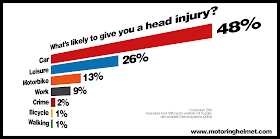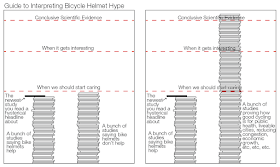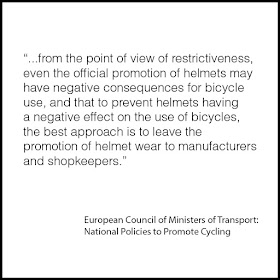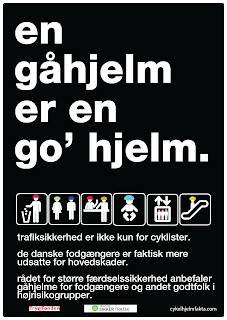
I took part in a radio debate last week. Four guests and a journalist. In that forty-five minutes, I experienced a number of things including, but not limited to, the anti-intellectualisation of our society, emotional propaganda, alternative facts, manipulative and selective choice of facts, The Culture of Fear and the negative branding of cycling.
You might expect I was on American or Australian radio. Nope. I was a 12 minute bike ride from Copenhagenize Design Company’s Copenhagen office - at Denmark’s national broadcaster, DR, on their flagship radio channel P1 Debat.
The occasion was a debate about bike helmets. The week before, a Danish media personality, Mads Christensen, tossed out a remark on a television programme about how he let his kids decide for themselves, at the age of eight, if they wanted to wear a bike helmet or not. His comments were simply based on rationality about real or percieved dangers in society. Nevertheless, they generated a great deal of debate on social media. A journalist and radio host, Bente Dalsbæk (The Journalist), decided to allocate 45 minutes to the subject.
Mads Christensen (The Rationalist) was there, of course. Also invited were Klaus Bondam (The Bike Advocate), head of the Danish Cyclists’ Federation; Torben Lund Kudsk (The Motorist), head of the Danish car lobby NGO, FDM; and yours truly.
I don’t often engage in discussions about bike helmets in Denmark and try to avoid them in other regions. I feel that it distracts from our work at Copenhagenize Design Company in designing infrastructure for cities. Like Chris Boardman - former pro-cyclists and policy advisor at British Cycling has said on BBC.com, "You're as safe riding a bike as you are walking," (a helmet is) "... not in the top 10 things you can do to keep safe."
http://www.bbc.com/news/magazine-29894590 I did this TED x talk in 2010 about The Culture of Fear related to bike helmets in order to NOT have to talk about it all the time.This article by Howie Chong entitled Why it Makes Sense to Bike Without a Helmet is also well worth a read.
What has shocked me is that the debate about helmets is at such a primitive level in this country. Even in hard-core helmet promotion regions elsewhere in the world, I can engage in discussions at a much higher level. The hysterical social media reaction to comments like those by Mads Christensen would be balanced by people aware of science and practicing rationality. Not so here in Denmark. The reactions were overwhelmingly hysterical and ignorant. Not to mention completely unworthy of a well-educated nation like Denmark. The 45 minute interview started with context, where The Rationalist explained his side of the story. He repeated his statement about rationality and risk assessment. When mountain biking the woods, he and his kids wear helmets. When cycling to the shops in the world’s safest bicycle nation or whatnot, he doesn’t and he allows his kids to make their own call. Sounds like an intelligent approach.Like almost everywhere else, kids have a higher risk of head injury in cars and in playgrounds and for adults, cars pose the greatest risk followed by being a pedestrian, being at home, gardening, etc.

Yes, life remains dangerous, although we live in a safer society than at any other point in the history of homo sapiens. The Culture of Fear, however, is the bogeyman. We can still construct fear of anything - including cycling. And wherever we can scare people, there are products to be sold to them.
After The Rationalist outlined his point of view in the radio debate, The Journalist started to gather points of view, starting with The Bike Advocate. Klaus Bondam stated his organisation’s standard position. They strongly recommend helmets but are against legislation to make them mandatory. I pointed out that The Bike Advocate is the head of the only national bicycle NGO in Europe that actively promotes helmets. It was then my turn to present my point of view. How science should be respected, how manipulating selective facts is fundamentally wrong. I did what I could with the short answering time allocated to me by The Journalist but I could see early on in the interview that it was rigged in favour of The Culture of Fear. Which made it a loooong 45 minutes. All the strategy for one-sided debate was present. The Journalist threw out a statistic about how 60% of head injuries could be avoided with a helmet. No, not 60% of ALL head injuries - she only meant bike crashes. The Bike Advocate threw out another select statistic. With the looks on their faces when they did so, you really sensed that they felt they were nailing the debate. The Journalist didn’t bothering questioning the statistic or the context of it in order to provide the listeners with a bigger picture. The Bike Advocate looked all pleased with himself at being able to quote a researcher name and the year of the study. While science is under fire in Trump’s America, there is another category that is equally detrimental to any debate. The One Study Argument. Just cast one study that produced one statistic into the debate and wham. You are portrayed as an expert. People who don’t know more about the subject have no response. Pity those poor fools. Let them bask in the glory of your One Study Argument greatness. That is not how science works, however. The bigger picture is more important.
That is not how science works, however. The bigger picture is more important.
Why is the debate at such a primitive level here in one of the world’s great cycling nations? The answer is simple. Lack of information - or rather a strictly controlled and manipulated information flow. In the Danish context, we must examine the tightly controlled information flow. Like you, wherever you are whilst reading this, we have a road safety NGO in Denmark. They call themselves The Danish Road Safety Council - Rådet for Sikker Trafik (The Safety Nannies).
 Via Yehuda Moon - http://yehudamoon.com/ This NGO is the puppet master controlling the flow of information about bike helmets. They have mastered the art. By doing so, they also contribute to the anti-intellectualisation of Danish society. They select one or two studies that adhere to their strict ideology and present it like the word of god to the masses. If individuals question it, the stats are merely repeated. The “60%” stat that The Journalist found and presented in the studio is their current one commandment carved in a stone tablet. It originates with the Norwegian Transport Economic Institute (TØI) and dates from 2004. It is perfect for them. It is a Scandinavian source from a fancy-sounding institute. Ironically, TØI has published other helmet-related studies since then and few would fit Sikker Trafik’s ideology. Better to ignore them and stick to the stat that works. You don’t need to explain WHY climate change is a hoax. You just have to repeat it ad naseum. Much the same communication strategy as The Safety Nannies employ and hand off to lazy journalists and pundits. It is a sad, flawed strategy that only fans the flames of anti-intellectualisation in any society but if you look at it, it is a brilliant strategy from a communication point of view. The Safety Nannies started their bike helmet promotion in the early 1990s in Denmark. Since then, cycling levels have continued to fall, which is what we have seen in many regions around the world. Danes are cycling more than 30% less today than in 1990. (If we got that 30% back, we could save over 1500 lives a year because of the health benefits of cycling, according to Professor Lars Bo Andersen of University of Southern Denmark, the most published academic about the health benefits of cycling) The positive aspects of having a cycling population are rarely presented in the current debate in Denmark. They are not sensationalist enough for journalists, apparently. In the middle of the interview The Journalist held up a printed out photo that she harvested from Facebook of a woman with a head injury. It was like a image version of the One Study Argument. “See?! Look at THAT...” End of debate. Showing photos of tens of thousands of people lying in hospital beds suffering from lifestyle illnesses like diabetes, heart disease, etc, due to inactivity is considerably less glamorous and have no place in sensationalist journalism. Another old chestnut was presented in the studio. 17,000 people visit a hospital each year as a result of a bike crash. I tried to put that number into context. The average in Denmark is 20,000, so I had calculated based on that number. If 18% of the population of Denmark ride a bicycle to and from work or education each day, that is 1,008,000 trips a week, Monday to Friday. Multiply that by 300 work days a year and you get 302,400,000 trips by bike. We’re not even including the trips to the supermarket, cafe, cinema, etc.
Via Yehuda Moon - http://yehudamoon.com/ This NGO is the puppet master controlling the flow of information about bike helmets. They have mastered the art. By doing so, they also contribute to the anti-intellectualisation of Danish society. They select one or two studies that adhere to their strict ideology and present it like the word of god to the masses. If individuals question it, the stats are merely repeated. The “60%” stat that The Journalist found and presented in the studio is their current one commandment carved in a stone tablet. It originates with the Norwegian Transport Economic Institute (TØI) and dates from 2004. It is perfect for them. It is a Scandinavian source from a fancy-sounding institute. Ironically, TØI has published other helmet-related studies since then and few would fit Sikker Trafik’s ideology. Better to ignore them and stick to the stat that works. You don’t need to explain WHY climate change is a hoax. You just have to repeat it ad naseum. Much the same communication strategy as The Safety Nannies employ and hand off to lazy journalists and pundits. It is a sad, flawed strategy that only fans the flames of anti-intellectualisation in any society but if you look at it, it is a brilliant strategy from a communication point of view. The Safety Nannies started their bike helmet promotion in the early 1990s in Denmark. Since then, cycling levels have continued to fall, which is what we have seen in many regions around the world. Danes are cycling more than 30% less today than in 1990. (If we got that 30% back, we could save over 1500 lives a year because of the health benefits of cycling, according to Professor Lars Bo Andersen of University of Southern Denmark, the most published academic about the health benefits of cycling) The positive aspects of having a cycling population are rarely presented in the current debate in Denmark. They are not sensationalist enough for journalists, apparently. In the middle of the interview The Journalist held up a printed out photo that she harvested from Facebook of a woman with a head injury. It was like a image version of the One Study Argument. “See?! Look at THAT...” End of debate. Showing photos of tens of thousands of people lying in hospital beds suffering from lifestyle illnesses like diabetes, heart disease, etc, due to inactivity is considerably less glamorous and have no place in sensationalist journalism. Another old chestnut was presented in the studio. 17,000 people visit a hospital each year as a result of a bike crash. I tried to put that number into context. The average in Denmark is 20,000, so I had calculated based on that number. If 18% of the population of Denmark ride a bicycle to and from work or education each day, that is 1,008,000 trips a week, Monday to Friday. Multiply that by 300 work days a year and you get 302,400,000 trips by bike. We’re not even including the trips to the supermarket, cafe, cinema, etc.
If 20,000 trips end in a crash and a hospital visit, that means you have, in Denmark, a 0.0066138% chance of crashing and going to the hospital. The vast majority of those injuries are minor and the person in question is back on a bike in, at the most, a couple of days. Motorists, by the way, end up in hospitals much longer when they get injured in their preferred mode of transport.
 According to the City of Copenhagen who endeavour to battle this Bicycle Misinformation War whenever they can, I have to cycle to work for 2800 YEARS before I get injured. So where was The Bike Advocate during this onslaught of manipulation and alternative facts? Was he deftly and professionally countering all the arguments about cycling being dangerous? You would hope so. He was, however, all over the map, sending conflicting messages about cycling. The Safety Nannies broadcast the number of 20,000 cyclists visiting hospitals to anyone who will listen. They are not content with that, however. They invented “mørketal” - or “dark numbers” as a way of further constructing fear about cycling. Cyclists also get hurt but DON’T visit the hospital and those dark numbers are an unknown. Yes. Cyclists who ARE OKAY and who have bandaids in their home after a minor mishap are now being used in the massive branding of cycling as an undesirable transport form. The Bike Advocate presented the listeners with this concept of dark numbers. Instead of defending cycling from the onslaught, he helped polish the rifles and load the ammo. A little later, he threw in a mix of neutral and positive angles to confuse anyone who was listening. There was no clear agenda from Denmark’s national cycling NGO. They refuse to acknowledge what most other cycling NGOs in Europe know - that merely promoting helmets is detrimental to cycling levels.
According to the City of Copenhagen who endeavour to battle this Bicycle Misinformation War whenever they can, I have to cycle to work for 2800 YEARS before I get injured. So where was The Bike Advocate during this onslaught of manipulation and alternative facts? Was he deftly and professionally countering all the arguments about cycling being dangerous? You would hope so. He was, however, all over the map, sending conflicting messages about cycling. The Safety Nannies broadcast the number of 20,000 cyclists visiting hospitals to anyone who will listen. They are not content with that, however. They invented “mørketal” - or “dark numbers” as a way of further constructing fear about cycling. Cyclists also get hurt but DON’T visit the hospital and those dark numbers are an unknown. Yes. Cyclists who ARE OKAY and who have bandaids in their home after a minor mishap are now being used in the massive branding of cycling as an undesirable transport form. The Bike Advocate presented the listeners with this concept of dark numbers. Instead of defending cycling from the onslaught, he helped polish the rifles and load the ammo. A little later, he threw in a mix of neutral and positive angles to confuse anyone who was listening. There was no clear agenda from Denmark’s national cycling NGO. They refuse to acknowledge what most other cycling NGOs in Europe know - that merely promoting helmets is detrimental to cycling levels.  Personally, I am sceptical when shopkeepers promote helmets. The Cyclists’ Federation has a bike shop. Several people in the industry cancelled their memberships back in the day when they opened a shop. The criticism was that an NGO for cycling should not promote one product over the other and remain neutral. In another twist, we still have emails in our archives from late 2007 and early 2008 when The Safety Nannies started their hardcore, emotional propaganda about bike helmets. What tipped it for them was that they convinced the Cyclists’ Federation to get on board. Colleagues from our industry informed me that the latter were promised influence and access to future funding if they joined the helmet brigade. They continue to deny this to this day. In Denmark, everything started with The Safety Nannies and their manipulated alternative facts are largely unchallenged by a society slowly dumbing down. Trump didn’t invent Trumpism, he just excels at it. Trump is merely a product of societal development. The same techniques are present everywhere. Interestingly, like Trump, The Safety Nannies in Denmark do not like being contradicted. They have actually spent time emailing journalists in Denmark and abroad about… me. Engaging in attempted character assassination with journalists and editors. Trying to discredit me. It is amusing. It only helps getting science printed and distributed. It also shows that their case is weak. You don’t go to all that effort if you are confident in what you are saying.
Personally, I am sceptical when shopkeepers promote helmets. The Cyclists’ Federation has a bike shop. Several people in the industry cancelled their memberships back in the day when they opened a shop. The criticism was that an NGO for cycling should not promote one product over the other and remain neutral. In another twist, we still have emails in our archives from late 2007 and early 2008 when The Safety Nannies started their hardcore, emotional propaganda about bike helmets. What tipped it for them was that they convinced the Cyclists’ Federation to get on board. Colleagues from our industry informed me that the latter were promised influence and access to future funding if they joined the helmet brigade. They continue to deny this to this day. In Denmark, everything started with The Safety Nannies and their manipulated alternative facts are largely unchallenged by a society slowly dumbing down. Trump didn’t invent Trumpism, he just excels at it. Trump is merely a product of societal development. The same techniques are present everywhere. Interestingly, like Trump, The Safety Nannies in Denmark do not like being contradicted. They have actually spent time emailing journalists in Denmark and abroad about… me. Engaging in attempted character assassination with journalists and editors. Trying to discredit me. It is amusing. It only helps getting science printed and distributed. It also shows that their case is weak. You don’t go to all that effort if you are confident in what you are saying.
Current helmet wearing rates in Copenhagen are at 11%. As we have come to expect, the debate also featured comments about “doctors and nurses say that...” Yet another technique in the debate. Who can doubt a medical professional?! They fail to realise that while those doctors and nurses excel at fixing people, they receive information about prevention from the same sources as everyone else. The one-way communication street from The Safety Nannies sends the same manipulated facts to doctors and nurses, too. Trust the medical professionals to make you better. Doubt the sources of their prevention advice. And notice that it is the trauma staff who get the best press. The doctors caring for those with lifestyle illnesses never get the same spotlight. The debate wandered into cyclist behaviour and the others agreed readily that “something has happened… cyclists are behaving more badly than ever before”. This is as amusing as it is wrong. Cyclist behaviour is largely unchanged for at least 120 years. There are countless articles, letters to the editor and editorials about cyclist behaviour over the past century. Not least this satirical piece by Denmark’s most loved satirist, Storm P.. Perhaps it is time to realise that cyclist behaviour can only be changed if we stop forcing them to adhere to traffic rules and traffic culture designed to serve the automobile. We sending badminton players to play with ice hockey rules. It has never worked so it is time to think differently. We have shown time and again with our Desire Line Analyses that behaviour among our cycling citizens is fine. Only 5% of cyclists smash through the traffic rulebook. Which is on a par with pedestrians and motorists. A recent poll in Denmark outlined how ignorance of a topic can have dangerous consequences. This is a society where The Safety Nannies have a monopoly on the information about cycling. Danes were polled about whether they want a helmet law. A majority said yes. You don’t get that result in many places anymore due to the balance of information in the debate. Except in Denmark. The Safety Nannies and The Bike Advocate have been pushing helmets hard. Now they are under fire for not supporting a bike helmet law. They have shot themselves in the foot.
It was a tough room. Countering emotional propaganda with an arsenal of science and rationality is difficult. I was in the line of fire as the others did what they could to continue this branding of cycling in Denmark as dangerous, using all the techniques we know from around the world. I tried to highlight facts like the Australian government’s study about motoring helmets, but to no avail. I just hope some listeners got the point.
I didn’t get to industrial design, unfortunately. People have been led to believe that a bike helmet can withstand a meteor strike. They have never been informed that a helmet is designed to protect the head in non-life threatening, solo accidents under 20 km/h. Or that helmets are tested in simulations that resemble a pedestrian falling - which makes them perfect for… pedestrians and people in their home. "A walking helmet is a good helmet" Nor did I get to say that most serious head injuries are not a result of a lateral impact, but rather a rotational impact. Something bike helmets cannot deal with. Sigh.
"A walking helmet is a good helmet" Nor did I get to say that most serious head injuries are not a result of a lateral impact, but rather a rotational impact. Something bike helmets cannot deal with. Sigh.
More people drown in Denmark each year than die in bicycle crashes. There is a missed financial opportunity there. Let’s pass laws making life vests mandatory within 2 metres of water. 35,000 Europeans die each year in cars. Think of the money to be made if we imported these from Australia (it is a real product).
It was a depressing debate session in that radio studio. Daily Mail tactics from The Journalist. Vague, conflicting and confusing messaging from The Bike Advocate. The Rationalist had his say, which helped, but at the end of the day, the sheeple will lean towards the strong-flowing current of misinformation from The Safety Nannies. You may recall that The Motorist was in the room, too. He didn’t say much. He didn’t need to. Would you? You have a national radio program completely trashing your main competitor. Car sales are at a four year high in Denmark. Just stand there and let them do it. I cycled back to the office and continued to work on our projects with cities who want to copenhagenize themselves. We’ll keep on keeping on. Designing their networks and infrastructure. Exporting the Copenhagen model. It is a good, transferable model. It is working to transform cities around the world. Embrace it. Everything else coming out of Denmark regarding negative branding, helmet promotion and The Culture of Fear… ignore it.Go talk to the Dutch. Start with this article about Dutch Rationality Saving Childrens’ Lives.
In Denmark, we're heading down this road:





